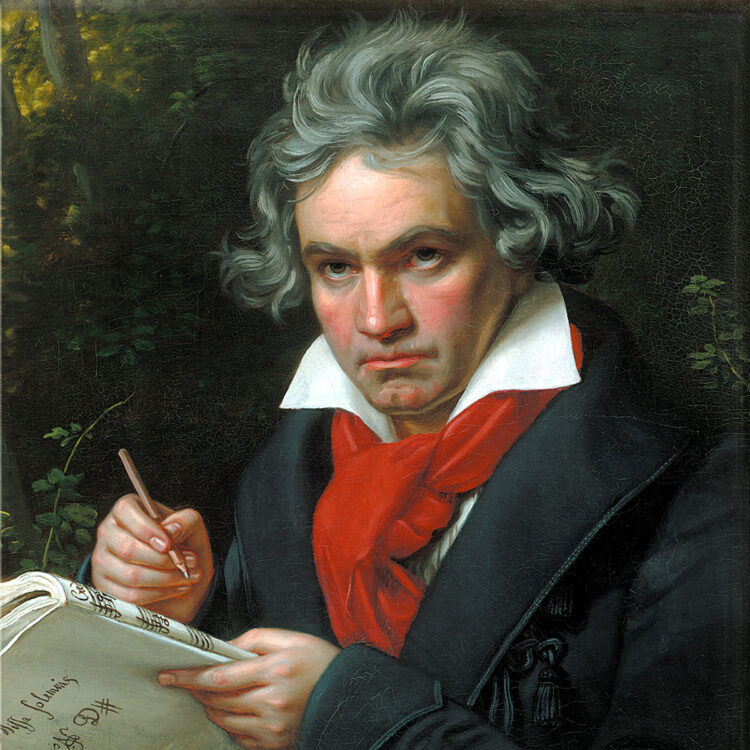Marcia funebre from Symphony No. 3, Eroica
Ludwig van Beethoven was baptized December 17, 1770, in Bonn, Germany, and died in Vienna on March 26, 1827. He composed his Third Symphony, the Eroica, between May and November 1803, with some further polishing early the following year. It was privately performed in the Vienna townhouse of Prince Joseph von Lobkowitz, to whom the score is dedicated, in the summer of 1804. With Beethoven himself conducting, the first public performance took place on April 7, 1805, in Vienna, at the Theater-an-der-Wien.
The score of the Eroica Symphony calls for 2 each of flutes, oboes, clarinets, and bassoons, 3 horns, 2 trumpets, timpani, and strings (first and second violins, violas, cellos, and double basses). The Funeral March is about 15 minutes long.
With Beethoven’s Third Symphony, as the composer’s biographer Maynard Solomon observes, “we know that we have crossed irrevocably a major boundary in Beethoven’s development and in musical history as well.” In its size and shape, in the density and complexity of its musical ideas, in its overall scope, in its psychologically complex link to extramusical associations (i.e., “the Napoleon connection”), it was worlds apart from any symphony written before it. The first movement alone, when the exposition repeat is included, runs half the length of an entire late Mozart or Haydn symphony. The funeral march represented an unprecedented novelty. Of the third movement, with its bustling energy, the scholar George Grove wrote that “before this…the Scherzo, in its full sense, was unknown to music.” Also in the Eroica Beethoven introduced a third horn to the symphony orchestra for the first time; the third-movement Trio takes full advantage of the added sonority. The theme-and-variations finale can still seem curious, a source of puzzlement; one commentator has even described it as “perhaps a little naive,” given the weight of what precedes it.
Beethoven composed his Third Symphony between May and November 1803, completing the work with some final polishing early in 1804. But the title Eroica seems not to have been used until the parts were first published, in October 1806, with the heading “Sinfonia Eroica composta per festigiare il Souvenire di un grand’ Uomo” (“Heroic Symphony composed to celebrate the memory of a great man”).
In October 1803, Beethoven’s friend Ferdinand Ries wrote to the publisher Simrock that Beethoven wanted very much to dedicate the new symphony to Napoleon, but that Prince Lobkowitz was interested in purchasing the performing rights—whereby the latter would become dedicatee, and Beethoven would simply name the work after Napoleon. A practical consideration was that Beethoven, frequently ambivalent toward Vienna, and considering a move to Paris, would have found a symphony named for or dedicated to Napoleon a useful calling card. Napoleon declared himself Emperor on May 18, 1804. A famous anecdote reported by Ries relates that Beethoven flew into a rage upon hearing of this (“Is he then, too, nothing more than an ordinary human being? Now he, too…will exalt himself above all others, become a tyrant!”), tore the title page of the score—which had the word “Buonaparte” at the top—in half, and rechristened it “Sinfonia eroica.” Yet even on August 26 that year, Beethoven wrote to the publisher Breitkopf & Härtel that “The title of the symphony is really Bonaparte.” But Beethoven’s apparent need somehow to express his political and ideological beliefs—whether in the dedication of the symphony or perhaps even in the language of the music itself—had also to be tempered by realistic concerns, especially given the strained relations between France and Austria at the time. Ultimately, the music must speak for itself. As Basil Lam has written, “the greatest human hero would be unworthy of the Eroica.”
II. Marcia funebre. Adagio assai. The funeral march, with its integral use of silence and sound, takes its basic form from that of a rondo: the recurring theme is the extended, dark march at the start of the movement, which is altered each time it returns: its second presentation is an intense fugue. Its last iteration is tentative, fragmented by deep sorrow. The composer Hector Berlioz wrote, “And when the tattered fragments of the mournful melody, alone, naked, shattered, erased, have collapsed, one after one…the wind instruments emit a cry, the last farewell of warriors to their comrade in arms.”
March Mandel
Marc Mandel joined the staff of the Boston Symphony Orchestra in 1978 and managed the BSO’s program book from 1979 until his retirement as Director of Program Publications in 2020.


